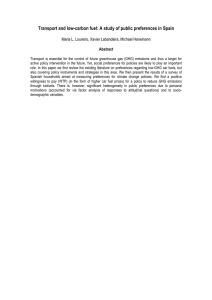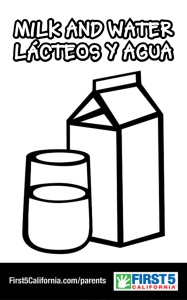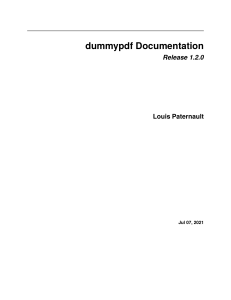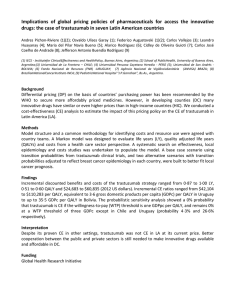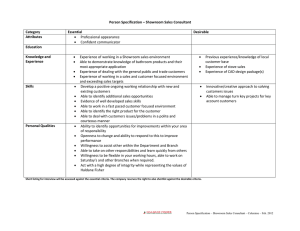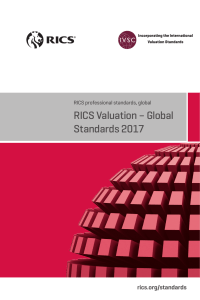Consumers` willingness to pay for milk quality attributes
Anuncio
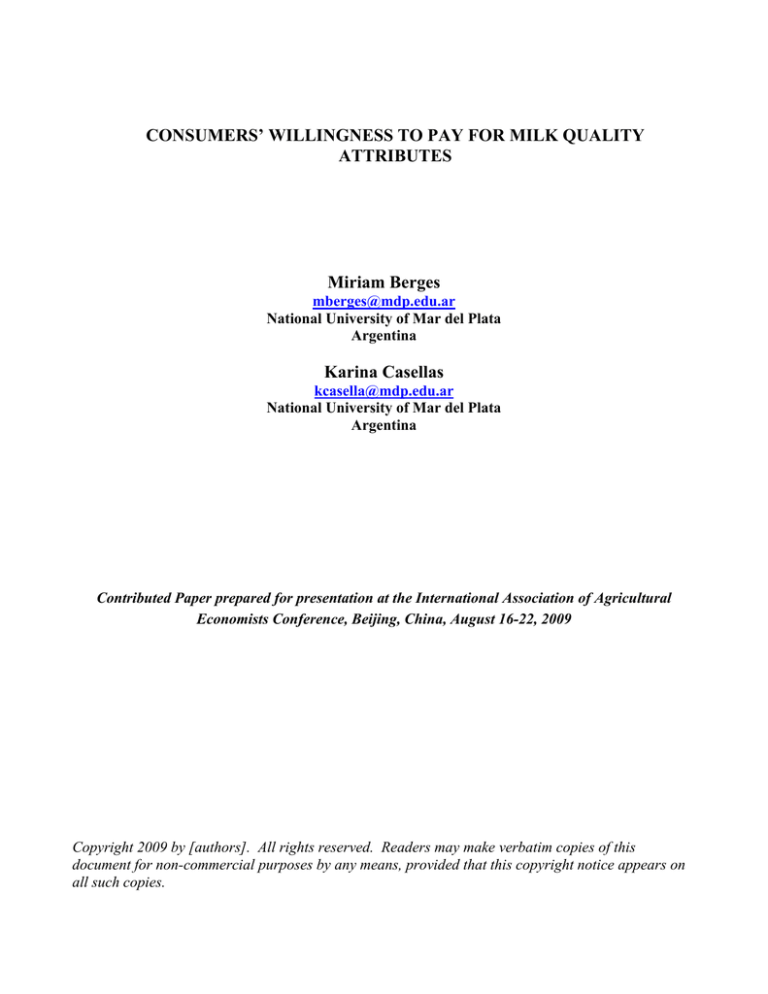
CONSUMERS’ WILLINGNESS TO PAY FOR MILK QUALITY ATTRIBUTES Miriam Berges [email protected] National University of Mar del Plata Argentina Karina Casellas [email protected] National University of Mar del Plata Argentina Contributed Paper prepared for presentation at the International Association of Agricultural Economists Conference, Beijing, China, August 16-22, 2009 Copyright 2009 by [authors]. All rights reserved. Readers may make verbatim copies of this document for non-commercial purposes by any means, provided that this copyright notice appears on all such copies. CONSUMERS’ WILLINGNESS TO PAY FOR MILK QUALITY ATTRIBUTES Abstract Supply and the demand for food products have experienced important changes in the last decades. From the supply side, the firms produce a great variety of products and quality and standards requirements are implemented along the supply chain. From the demand side, new preferences for food products arise promoted by socio-demographic and consumer behavior changes. Additional nutrients and enhanced production processes are considered quality attributes over which consumer decides at the purchase choice. Following contingent valuation method, this paper evaluates willingness to pay for quality attributes using fluid milk as study case and the data of a consumer survey conducted in Mar del Plata city, Argentina. Our results suggest a low willingness to pay in spite of consumers’ concerns about food quality. WTP rises with the level of information they process and with quality and food safety priorities rather than price at purchasing food. Key words: Willingness to pay – Quality attributes- Fluid milk- Contingent Valuation JEL Codes: C25 - D13 This study was financed by Project ALCUE-FOOD. Work package 3 (INTA, COPAL, EMBRAPA, CIRAD, CECYT, INIA, INAP). “From European fork to Latin American farm”: an innovative networking platform for EU–LAC partnerships in food quality and safety R&D CONSUMERS’ WILLINGNESS TO PAY FOR MILK QUALITY ATTRIBUTES Introduction Consumers’ perceptions of quality and food safety attributes not only are important for producers and retailers but also are essential for policy makers. The changes in demand determinants are the core to evaluate the impact on the consumers’ welfare of the government regulations. Also this kind of knowledge is valuable for the development of commercial strategies such as product differentiation or certification or labeling programs. Reinforced controls or, at least, a more strict application of already existing regulations, have increased production marginal costs at the producer, wholesale and retail levels. These increases are ultimately transmitted to consumers through higher price. Improving the nutritional value of staple food crops has usually been a secondary concern for highincome consumers, who have access to improved nutrition through dietary diversification (Unnevehr et al, 2007). Market forces have tended to reward higher yield far more than higher nutrient content, and crop breeders have often felt they must sacrifice the latter to get the former. This is one reason most efforts to fortify foods with micronutrients have taken place off the farm in the downstream processing and formulation of food products and often through regulatory interventions that go beyond market forces. On the demand side, consumers rarely have full information about either the short- or long-term effects of dietary choices. Constraints of income, cultural practices, tastes, and habits are much stronger determinants of food choice than nutritional quality. In consequence, producers not have incentives to invest in improving food nutritional content. It is now recognized that micronutrient deficiencies are persistent public health problems, like food safety, that require direct intervention during the process of economic development (Unnevehr et al, 2007). Food fortify is an example of a credence attribute. This type of attributes cannot be discerned by consumers even after consuming the product. In order to address the market and policy concerns related to nutritional policies, policy-makers need additional consumer information to understand the relative value of fortification. This research provides insight on whether Argentinean consumers are likely to be willing to pay for mineral fortify and food safety certification. And, especially, contributes to the discussions on the extent and the limitations of the strengths behind the demand to drive these changes in contexts of restriction of income and imperfect information. Individuals’ choices are influenced by habit, inertia, experience, advertising, accumulated opinion, environmental constraints, household and family constraints, etc. This set of influences reflects the temporal nature of choice outcomes and segments within the constraints (Louviere, Hensher and Swait, 2006). These sources of influence are essential to both the development and estimation of the basic choice model as they represent the constituent ingredients of the representative component of the utility function. The objective of this paper is to estimate how much Argentinean consumers are willing to pay for food quality attributes. Moreover, the paper aims to discover the main factors in this consumer decision process. In order to elicit consumers’ WTP, we used contingent valuation (CV) method and a logistic model for dichotomous or discrete choice approach. The food selected for this work is the fluid milk and the attributes are i) an additional mineral (zinc) with beneficial effects on health and ii) an additional process that improves the milk quality. The paper is organized as follow, first a review of the research literature on the relationship between quality perception and consumer purchasing intentions. Second, the econometric framework used to estimate the model. Third, the data source and the design of the questionnaire yielding some preliminary and descriptive results are presented. Finally, the results from the estimated model are discussed, followed by some conclusions. Conceptual Framework Quality is a very complex concept, dynamic and culturally structured. It includes food security and safety, nutrition and others attributes related with product differentiation. In a narrower sense, quality is a surplus over the requirements that firms highlighted as a differentiation strategy. Consumers are more concerned with quality issues, healthy and production processing aspects of the products they consume. Many of these attributes can not be evaluated by visual perception or by the experience after being consumed. Therefore (and because of this), asymmetric information problem arises in the food market. Individuals have a bounded knowledge of quality and considering the consumers ability to distinguish it, goods can be classified into search, experience (Nelson, 1970) or credence goods (Darby and Karni, 1973). The dairy industry is one of the most worried about food safety perceptions and quality warranties. Fuller and Hu (2005) argued that dairy industry based its brand name reputation on its high quality product supply. Food safety is a credence attribute and consumers have to rely on intrinsic and extrinsic cues to infer food safety. Among the extrinsic cues, traceability and/or quality labels have been implemented both at European and national levels. The main objective of these policies has been to transform food safety from a credence attribute to a search attribute (Angulo and Gil, 2007). An important topic related to imperfect information in the food market is consumers’ ability of processing it and inferring about quality. Barreiro Fernández et al. (2001) highlight the roll quality perceptions play and the way they support consumer choices among different alternatives. It’s necessary to differentiate between real quality and perceived quality. The perceived quality is a global or multidimensional valuation consumer does of the product, linked to his expectatives and to his choice conditionings attributes. There are two different methodologies to study the consumer behavior: Revealed Preference (RP) or Stated Preference (SP). The first approach focuses on the observation of consumer behavior at the market to estimate his ex-post willingness to pay. The main assumption is that the information comes from a real fact, a market transaction. The second approach is based on hypothetic data to estimate ex ante willingness to pay for attributes not available yet in the market. The methods applied on this approach are: contingent valuation (CV), experiments design and experimental auctions. Milk is a product very often purchased and consumers generally know the available alternatives at the market (types, brands and prices). Casellas et al, (2004) suggested that milk and dairy are products most consumers feel concerned in relation with quality. There is also a subjective component with milk nutritional properties. People suppose it is necessary for a healthy and balanced diet, specially recommended for children. This implies an additional concern about its quality. Methodology The contingent valuation method is known as hypothetic method because of the way researchers obtain the economic value individuals assign to a good or attribute. The standard procedure consists of designing a survey which describes the good or attribute characteristics. It directly gives the good or attribute’s valuation and it is compatible with Hicksian welfare measures. In our case, it is the compensating variation or the willingness to pay (WTP) for a welfare gain. The dichotomous or discrete choice VC format introduced by Bishop and Heberlein (1979) has great acceptance because it only requires responding yes/no in relation with a given payment “A” instead of an exact estimation of the monetary value consumer would be willing to pay. This format is known as referendum or closed ended question with a given value or bid price1. It induces to reveal more honestly the interviewed preferences –is incentive- compatible-. However, CV method introduces new questions not easily solved such as the optimal sample size for the valuation experiment, the bid values range and the “right” model specification. As the dependent variable has a discrete format, it takes 1 value if the individual is willing to pay the payment “A” suggested in the survey and it takes zero value if not, the econometric estimation requires maximum likelihood procedures. The regression errors are generally assumed to be normal or logistic distributed and estimation procedure is probit or logit respectively. Hanemann (1984) and Cameron and James (1987) developed theoretic frameworks to estimate welfare changes compatible with the CV method. Hanemann original idea is known as the indirect utility difference model –supported by McFadden random utility framework- while Cameron’s idea is the expenditure difference model to estimate a random WTP. The goal of estimating parametric models from dichotomous choice CV responses is to calculate willingness to pay for the attribute described. In addition, parametric models allow for the incorporation of respondent characteristics into the willingness to pay functions and to learn more about the individuals’ preferences or characteristics influence over the WTP –the covariate effects-. Though it’s possible to estimate WTP from non parametric models, like Turnbull estimator presented in this paper, it implies missing the effect of additional variables information over the WTP. 1 The bid price is one from a serial of possible values that depends on the sample size. Each individual interviewed is requested about one proposed payment randomly selected. An important methodological question arises from the consistency between statistical and economic assumptions and the choice models selected. Bounds on WTP can be implemented in two ways. One is to estimate an unconstrained model and to truncate the final welfare measure at the calculation stage – not acceptable is the truncated distribution of the WTP is not close to one-. The second approach is to estimate a model with the right bounds from the beginning. According with Haab and McConnell (2002), a direct way to achieve this using Cameron’s approach is to specify the following model: WTPj = G ( z j γ + ε j ) y j (1) 0 ≤ G ( z j γ + ε j ) ≤ 1 ; G '( z j γ + ε j ) ≥ 0 y j =1,..,n Each j individual WTP is a proportion of income (y) and G is a function of an n dimensional vector (z) of household characteristics and choice influences. A recommended version of this formulation is: WTPj = yj 1 + exp(− zγ − ε ) (2) If ε ∼ logistic(0, σ 2 ) , the probability that the jth individual responds yes to the question about his willingness to pay $A for a gain welfare -a better quality product- is given for the following expression: y −A ⎡ ⎤ ⎫⎪ ⎪⎧ Pr( yes ) = 1 − FWTP ( A) = ⎨1 + exp ⎢ (− z jγ − ln( j )) / σ ⎥ ⎬ A ⎣ ⎦ ⎭⎪ ⎩⎪ −1 (3) The literature has focused on two measures of central tendency to evaluate the change between the initial and final situation for the population, the mean and median of the WTP distribution. The first is equivalent to apply the Kaldor-Hicks compensating criteria because the mean is positive if the positives values more than compensate the negatives values in the distribution. Median is equivalent to apply the majority criterion, the change is desirable if most of population votes for it. In this work, the median is calculated due to its direct calculus possibilities2. The expression to calculate the median is: MD (WTPj ) = yj 1 + exp( − z j γ ) (4) The Data The questionnaire was designed in four sections. In the first one, respondents were asked about their preferences on food choices and particularly on fluid milk. In the second, we recovered information about their habits, health status and their knowledge about food quality information. In the third section, they responded the WTP questions and, finally, the households’ socioeconomic characteristics were elicited. The sample was randomly administered in different Mar del Plata’s neighborhoods on May 2008. It was designed according with the first 2007 trimester data of Permanent Household Survey conducted by the National Institute of Statistics and Census, in terms of age, education and income characteristics. We obtained 336 valid responses and the sample proportions matched the population ones with the only exception of the income distribution. The middle income range -$1000 to $3000- is overrepresented. Table I shows the sample socio-demographic characteristics and Table II, the households income distribution. Consumers concerns about their food purchases were classified by a self interpretation of Gao (2007) according their quality attribute perceptions. As Table III indicates, most of people mentioned quality and the price as their priorities for food choices. The complexity to define quality is revealed by 2 WTP mean requires numerical procedures to integrate under the survival function of the WTP but, because the logistic distribution have median equal to zero, median WTP with respect to the errors for the bound logit model can be calculated as (4). the multiple responses indicating quality and some specific attribute that should be included in it. The 62% of the interviewed individuals believed that brand guarantees the quality on food, 23% trusted more in the purchasing place and 15% trusted on quality certifications. TABLE I. DEMOGRAPHIC CHARACTERISTICS OF THE RESPONDENTS. (N=336) Age Total Primary school Secondary school University 20-29 25,0% 3,6% 14,6% 6,8% Males 10,4% 2,1% 6,3% 2,1% Females 14,6% 1,5% 8,3% 4,8% 30-59 54,5% 12,8% 21,7% 19,9% Males 27,4% 6,5% 10,4% 10,4% Females 27,1% 6,3% 11,3% 9,5% More than 60 20,5% 11,0% 5,4% 4,2% Males 7,7% 4,5% 2,1% 1,2% Females 12,8% 6,5% 3,3% 3,0% Total 100,0% 27,4% 41,7% 31,0% Males 45,5% 13,1% 18,8% 13,7% Females 54,5% 14,3% 22,9% 17,3% TABLE II. HOUSEHOLDS INCOME DISTRIBUTION Less than $1.000 Number of respondents 48 Sample proportions % 14.29 Sample Design % 20% Between $1.000 and $3.000 176 52.38 45% More than $3.000 112 33.33 35% Total 336 100.00 100% Households Income Level The average price arisen from the survey –a direct question posed to the interviewed persons- was $2.30 with a maximum value of $4.5 and a minimum of $1. Households’ consumption mean was 4.5 liters/week and per capita consumption mean was 2.7. Over 77% of milk shoppers selected the product looking for brand names. Most of them (80%) declared they read food label information -65% always read- and those who said not to do it, argued that they had no time, they relied in brands or they delegated this task in another household member. What they usually most read is the expiry date and the nutritional content. TABLE III – FOOD SHOPPERS MAIN CONCERNS Number of Responses % 21 3.4 22 3.6 7 1.1 - Expiry date 61 10.0 -Hygiene 14 2.3 - Purchase place /origin 5 0.8 -Without additive- natural 16 2.6 - Brand 13 2.1 - Price 99 16.2 Quality 147 24.0 Nutritional Attributes - Fat, sodium or nutrients content Functional Attributes - Packaging Organoleptic attributes -Flavor Food Security Attributes Extrinsic aspect The 69% of the interviewed people was informed about food healthy properties, mainly reading about it (40%), watching TV and informally talking (35%). Only a 16% consulted professionals for information. Over 65% of respondents qualified his health state as good, 24% very good and 11% as not good. The 55% performed physical activity and the 50% was concerned with reduction of dietary fat intake. Only 13% consumed vitamins or antioxidants. The mean of the respondents’ age in the sample was 44 years, 45 for females and 44 for males. The sample distribution for the interviewed individuals’ occupation was: 36% employees, 19% professionals, 13% owners of their own business and 32% were non active people -12% retired people, 11% students and 9% housewives-. The mean of the households size was 2,8 members with a maximum of 9. The sample proportions for households types were: 21% single, 28% familiar without children and 51% familiar with children (43% under twelve years). Estimation Results The estimated model restricts the WTP inside the range economically plausible, as a share of consumers’ income. In our case, the proportion depends of maximum WTP observed ($2.30 that is equivalent to 100% of the milk average price). In this way, we only change the scale not the results because the maximum WTP is a share of the households’ income too. We estimate separate models for WTP to fortify milk with zinc and for WTP to additional process that improve milk quality. Table V presents variables definitions and Table VI parametric coefficient estimates for WTPZ and WTPP. Although the estimations are significant, not all the parameters are fully significant. In spite of this, we keep socioeconomics variables in both estimations in order to control their effects. In general terms, the signs of parameters are consistent with expectations except for education levels. The variable Education is not significant for none of both estimations. In the case to WTPZ, Leduc and Heduc have positive sign. This can be the result of a bias produced by the type of collect data instrument used. TABLE V- DEFINITIONS OF VARIABLES (N=316) Variable Types of Variable Definitions Mean Linc Binary Dummy variable which takes the value 1 if the household’s income is lower than $1000 0.14 Hinc Binary Dummy variable which takes the value 1 if the household’s income is higher than $3000 0.33 Young Binary Dummy variable which takes the value 1 if the respondent is younger than 30 years 0.26 Older60 Binary Dummy variable which takes the value 1 if the respondent is older than 60 years 0.19 Leduc Binary Dummy variable which takes the value 1 if the respondent has only primary school, and 0, otherwise 0.28 Educ. Binary Members Continuous Dummy variable which takes the value 1 if the respondent has a college degree, and 0, otherwise Numbers of households’ members Children Binary Dummy variable which takes the value 1 if there are children under twelve in the household. 0.24 Cprice Binary Dummy variable which takes the value 1 if the respondent is concern abut price, and 0, otherwise 0.29 Dummy variable which takes the value 1 if the respondent is concern abut quality, and 0, otherwise 0.45 Cquality Binary 0.32 2.76 CSafety Binary Dummy variable which takes the value 1 if the respondent is concern abut food safety, and 0, otherwise 0.28 Infood Binary Dummy variable which takes the value 1 if the respondent is informed about food attributes 0.70 Dummy variable which takes the value 1 if in the households live two or more people who perceive income, and 0, otherwise. 0.38 Dummy variable which takes the value 1 if the respondent read o search for quality certifications. 0.13 Dummy variable which takes the value 1 if the respondent believe to have very good health. 0.24 Represent the random amount each respondent was asked to pay. Bids or extra amounts were used (+10%, +20%, +30%, +40% and +50%). 0.67 Binary D-Inc ReadQCert VGHealth A Binary Binary Continuous In spite of our expectations, variables related with intrinsic attributes such as types of milk or those related with healthy habits were not statistically significant for either equation. Consumers who care about quality or food safety when buying food are more likely to pay a premium for zinc additives and safe process. In addition, consumers who declare to be informed about food benefits are more likely to pay a premium for both types of food quality attributes. TABLE VI- PARAMETER ESTIMATES FOR WTPZ Y WTPP WTPZ Variables Coeff. St.Error WTPP Z-Stat. Prob. Coeff. St.Error Z-Stat. Prob. LINC -0.5373 0.4089 -1.3137 0.1889 - HINC -0.2646 0.3220 -0.8216 0.4112 - YOUNG -0.2252 0.3334 -0.6753 0.4994 -0.4999 0.3312 -1.5093 0.1312 OLDER60 -0.3908 0.3739 -1.0450 0.2960 -0.5065 0.3848 -1.3163 0.1881 * -0.0817 0.3422 -0.2389 0.8112 LEDUC 0.7749 0.3512 2.2060 0.0274 HEDUC 0.0131 0.3305 0.0397 0.9683 0.0528 0.3122 0.1693 0.8655 * -0.1011 0.1168 -0.8655 0.3868 MEMBERS -0.2392 0.1240 -1.9290 0.0537 CHILDREN 0.2584 0.3518 0.7346 0.4626 0.2016 0.3471 0.5808 0.5613 * -0.3467 0.3226 -1.0748 0.2824 CPRICE -0.6807 0.3303 -2.0605 0.0393 CQUALITY 0.3660 0.2842 1.2877 0.1978 0.7084 0.2889 2.4519 0.0142* CSAFETY 0.4355 0.3215 1.3544 0.1756 0.3455 0.3223 1.0720 0.2837 * INFOOD 0.7834 0.3052 2.5665 0.0103 0.6261 0.3072 2.0382 0.0415* D_INC 0.5480 0.2908 1.8841 0.0596* 0.4825 0.2813 1.7148 0.0864 READQCERT - 0.6040 0.3667 1.6470 0.0995 VGHEALTH - -0.6885 0.3290 -2.0914 0.0365* LN((MaxWTP-A)/A) 0.8074 0.1705 4.7336 0.0000* 0.3485 0.1671 2.0848 0.0371* C -1.6116 0.5275 -3.0550 0.0022* -1.5713 0.5322 -2.9521 0.0032* Log likelihood -180.47 LR (14) 55.58 -180.52 Prob= 0.0000 37.91 Prob= 0.0005 (*) Significant at 5% As it was to expect, consumers who concern about price when buying food are not likely to pay a premium for zinc and is not statistically significant in the WTPP equation. Members variable is negative and significant only in the WTPZ equation and Vghealth variable is positive and significant in the WTPP estimation. Despite that, Hinc is negative and not significant, D-Inc variable (double income in the household) tries to capture less probability of income restrictions but more probability of time constraints. Several studies have already examined the effect of time in purchase decisions. Consumers with time constrain, minimize transaction costs and are more likely to pay for brand and convenience attributes. The final specifications of the WTP equation for milk fortified with zinc (replacing yj by MaxWTPj) is as follows: (5) WTPZj = 2,303 /(1 + exp(0, 665LINC + 0,328 HINC + 0, 279YOUNG + 0, 484OLDER 60 −0,959 LEDUC − 0, 016 HEDUC + 0, 296 MEMBERS − 0,32CHILDREN + 0,843CPRICE −0, 453CQUALITY − 0,539CSAFETY − 0,97 INFOOD − 0, 678 D _ INC + 1,9959 − ε j )) And for WTP equation for quality process is: (6) WTPPj = 2,303 /(1 + exp(1, 434YOUNG + 1, 453OLDER 60 + 0, 234 LEDUC − 0,151HEDUC +0, 290 MEMBERS − 0,578CHILDREN + 0,994CPRICE − 2, 033CQUALITY − 0,991CSAFETY −1, 796 INFOOD − 1,384 D _ INC − 1, 733READQCERT + 1,975VGHEALTH + 4,508 − ε j )) The median value of WTPZ is $0.34 equivalent to 15 % of the average milk price while median value of WTPP is $0.20 (9%). Given that, most of the variables are binary, only have sense, the analysis with or without the presence of some characteristics. For example, i) Only 50% of consumers older than 60 years, with low income, concern about food price is willing to pay 2 cents for zinc and is not likely to pay for an extra quality process. ii) But, if the consumers’ age is between 40 and 50 years, with low education, middle incomes, with children under 12 years old, concern about food safety and households’ double income, the median value of WTPZ is $1.73 (75% more) and 0.40 cents (17% more) for extra quality process. iii) The 50% of consumers with high income and education, between 40 and 50 years old, well informed of food attributes, with children under 12 years old and double income are likely to pay a premium price of $1 (45%) for zinc and $2,2 (96%) for quality process. Finally, we estimate no parametrically the lower bounds for the mean and the median WTP. The range in which median WTP falls can be obtained because the NO response proportions are consistent estimates of the distribution point masses at each price. The price for which the distribution function passes 0.5 is the lower bound on the range of median WTP. This estimation only uses the minimal amount of information and it is presented to compare with the CV Model estimates, because many of the covariables used in it are not significant. Table VII shows the NO response frequencies for each price A – five prices in our case (M=5)-. It can be observed that NO proportion for ZINC fulfils the increasing monotonic necessary condition to obtain the Turnbull estimator, but this is not true for PROCESS and data must be pooled back for the two higher prices. TABLE VII- TURNBULL ESTIMATES Offered Prices (Aj) Number of Responses Number of NO Response (Nj) NO Proportion (Nj /Tj)=Fj fj =Fj – Fj-1 (Fo =0 Fj+1 =1) (Tj) TZj TPj NZj NPj FZj FPj fZj fPj 10% ($0,23) 68 68 28 40 0.411 0,588 0.411 0,588 20% ($0,46) 66 66 38 41 0.575 0,621 0.164 0,033 30% ($0,69) 63 63 42 42 0.666 0,667 0.091 0,045 40% ($0,92) 59 59 45 45 0.762 ** 0.096 ** 50% ($1,15) 60 60 46 45 0.767 0,756 0.005 0,090 316 316 199 213 0.233 0,244 The range for the median WTPZ is 10% to 20% ($0.23 a $0.46) indicating that the majority of consumers would not pay more than a value between these prices. The range for the median WTPP is the previous one, 0% to 10%, and the majority of consumers, consequently, would be willing to pay less than $0.23 for an additional process to enhance the hygienic quality of the milk production process. Equation (7) and (8) present the formula to obtain the lower bound of mean WTP and its variance. M ELB (WTP) = ∑ Aj ( Fj +1 − Fj ) j =0 (7) M F j (1 − F j ) j =1 Tj V ( ELB (WTP )) = ∑ ( Aj − Aj −1 ) 2 (8) Lower bounds estimates for mean WTP are $0.41 (18%) for ZINC attribute and $0.39 (17%) for PROCESS attribute. The variance is the same for both cases $0.04 (1.7%). Conclusions The strategy of product differentiations are promoted by public sector to improve some productive activities as well as, by the private sector to increase their brand value. Empirical studies about consumer’ wiliness to pay for quality attributes increase the probability of strategies’ success. The estimated WTP can be used as an input or proxy of demand change in the welfare analysis of food policy and provide useful information for food companies to make decisions on food labeling programs. Results indicate that consumers’ WTP for food quality attributes is relatively low, though is greater for fortification (10-20%) than quality process (less than 10%). These values increase if consumer are informed about food attributes and read labels. References Angulo A. y Gil J. (2007) Risk perception and consumer willingness to pay for certified beef in Spain. Food Quality and Preference 18 (2007), pp. 1106–1117. Barreiro Fernández, J.M.; Losada Pérez, F y Ruso Sanmartín, E. (2001) Valor de Marca, calidad percibida y calidad real: un análisis comparativo del mercado de la leche. Estudios Agrosociales y Pesqueros, nº 190, pp. 195-221. Bishop, R and Heberlein, T (1979) Measuring Values of Extra-Market Goods; Are Indirect Measures Biased? American Journal of Agricultural Economics 61:926-30 Casellas, K; Berges, M y Liseras, N (2004) ¿Creer o no creer? La actitud del consumidor y los atributos de calidad basados en la confianza. Asociación Argentina de Economía Política. Noviembre 2004. Cameron, T and James, M. (1987) Efficient Estimation Methods for Use with Closed-Ended Contingent Valuation Survey Data. Review of Economics and Statistics. 69:269-76 Darby, M.R. and Karni, E. (1973) Free Competition and the Optimal Amount of Fraud”. Journal of Law and Economics. 16. p.67-88. Fuller, F, Hu, D (2005) Dairy Products in Southwestern China: Anecdotal Evidence from kunming. Presented at WERA-101 Meeting. Reno, NV April. Gao, Z. y Schroeder, T. (2007). Effects of Additional Quality Attributes on Consumer Willingness to Pay for Food Labels. Paper presented to Annual Meeting, American Agricultural Economics Association, Portland, Oregon, July, 2007. Gázquez Abad, J.C. y Sánchez Pérez, M. (2007). Consideración de la heterogeneidad en el comportamiento de la elección del consumidor a través de modelos logit: enfoque paramétrico vs. Semiparamétrico. Cuadernos de Economía y Dirección de Empresa. Nº 30, pp. 233-264. Almería, España. Haab, T. and McConnell, K (1998) Referendum Models and Economic Values: Theorethical, Intuitive, and Practical Bounds on Willigness to Pay. Land Economics. 74:216-29 Haab, T. and McConnell, K. (2002) Valuing Environmental and Natural Resources. The Econometrics of non-market valuation. Edward Elgar Publishing. UK. Hanemann, W.M. (1984) Welfare Evaluations in Contingent Valuation Experiments with Discrete Responses. American Journal of Agricultural Economics. 66: 332-41. Hanemann, W.M. (1989) Welfare Evaluations in Contingent Valuation Experiments with Discrete Response Data: Reply. American Journal of Agricultural Economics. 71: 1057-61. Hanemann, W. M and Kanninen, B. (1998) The Statistical Analysis of Discrete-Response CV Data. Working Paper Nº 798, Department of Aricultural and Resourse Economics and Policy. Division of Agricultural and Natural Resources. University of California at Berkeley. Hensher, D.; Rose, J. and Greene, W (2005).Applied Choice Analysis. A Primer. Cambridge University Press. Nelson, P., (1970) Information and Consumer Behaviour. Journal of Political Economy. Vol 81, pp. 311329. Portney, (1994). The contingent valuation debate: why economists should care. Journal of Economic Perspective 8, 3-17. Unnevehr, L.; Pray, C. and Paarlberg, R. (2007) Addressing Micronutrient Deficiencies: Alternative Interventions and Technologies. AgBioForum, 10(3): 124-134 Vasquez Lavin, F.; Cerdá Urrutia, A. y Orrego Suaza, S. (2007) Valoración económica del ambiente. Ed. Thomson Internacional.

